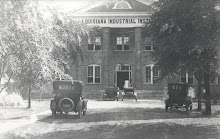
Camp Ruston

Camp Ruston was one of the largest prisoner of war camps in the United States during World War II, with 4,315 prisoners at its peak in October 1943.
Construction
Camp Ruston was built by the local T.L. James Company on 770 acres about seven miles northwest of Ruston, Louisiana in 1942. The land was purchased for $24,200, and construction cost $2.5 million.
POW camp

From June 1943 to June 1946, the camp served as one of more than 500 prisoner of war camps in the United States. The first 300 men, from Field Marshall Erwin Rommel’s elite Afrika Korps, arrived in August 1943. In 1944, the captured officers and crew of Unterseeboot 505 were sent to the camp and kept in isolation in a restricted area in order to prevent them from communicating to the enemy that secret German naval codes had fallen into Allied hands.During 1944, French, Austrian, Italian, Czech, Polish, Yugoslav, Romanian, and Russian prisoners were also housed in the camp. During their incarceration in Camp Ruston, the prisoners benefited from food, medical care, and physical surroundings which where better than what their countrymen were experiencing at home. They were permitted to engage in athletic and craft activities and allowed to organize an orchestra, a theater, and a library.Those prisoners who were enlisted men were required to work at the camp and for local farms and businesses. They picked cotton, felled timber, built roads, and performed other tasks to help solve the domestic labor shortage caused by the war. They were paid in scrip which they could use in the camp canteen.In 1944, the War Department began a program to educate prisoners of war throughout the United States in academic subjects and democratic values. One source of books was the library of Louisiana Polytechnic Institute (now Louisiana Tech University). Some prisoners even took correspondence courses from major American universities.Only 34 prisoners escaped and remained free for over 24 hours, and only one was never recaptured. At least nine prisoners died at Camp Ruston. These resulted from previous wounds and illnesses, or, in one case, from an attack by other prisoners.The last prisoners left Camp Ruston in February 1946 for repatriation to native countries. From 1947 to 1958, the site served as a state tuberculosis sanatorium, and it became the Ruston Developmental Center in 1959.
Camp Ruston Documentation Project
In the 1990s, increased efforts were undertaken to preserve the history of Camp Ruston. In 1992, the camp’s remaining buildings were placed on the National Register of Historic Places, and, in 1994, Louisiana Tech University and the Ruston Developmental Center began the Camp Ruston Documentation Project to collect historical materials concerning Camp Ruston.During 1994-95, several events and activities were held which brought attention to Camp Ruston. These included an archaeological survey of the Camp Ruston site, a symposium, talks to regional historical organizations and to school children, appearances on local television, exhibits, slide presentations, and provision of material for a taped segment on Camp Ruston for the LPB-TV program “Louisiana: The State We’re In.”



